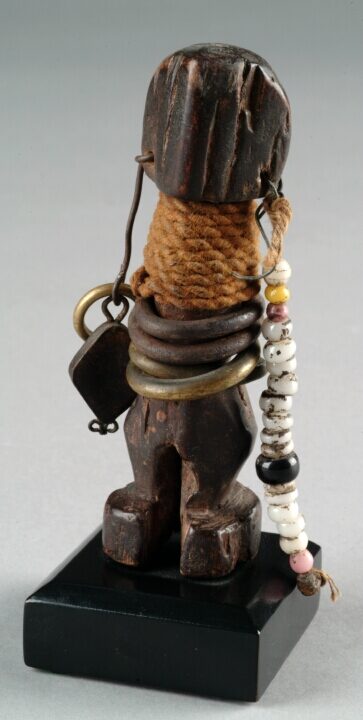Power Figure
Zande

Description
Subject Matter:
This yanda figure is attributed to the Zande, a North Central African group who today live in the Democratic Republic of the Congo, South Sudan, and the Central African Republic. Yanda figures are named after the protective spirit of the Mani secret society, an association admitting male and female members that was first established in the northern Congo basin toward the end of the nineteenth century to counter the authority of royal chiefs and later Belgian colonialists, both of whom, in turn, viewed it as a subversive cult. The society’s activities were significantly curtailed by the colonial administration in the early twentieth century.
Yanda figures are small carvings made of wood, terracotta, or soft stone and can be male, female, and zoomorphic. Six types of yanda figures have been identified; this one is a nazeze-type characterized by its highly abstract, schematic style and minimal physical features.
Yanda figures were believed to be imbued with the power to protect against illnesses, infertility, and malevolent forces as well as to ensure societal harmony and success in hunting and fishing. The operators of Mani lodges, bandakapa consecrated and activated yanda figures by applying libele, a plant mixture, to its surface. Sometimes, medicinal substances would be placed inside a cavity in the figure’s abdomen. A yanda figure would be concealed in a special receptacle and brought out whenever a member sought its assistance in fulfilling a particular need. While disclosing the problem to the yanda, the petitioner would anoint it with libele. Upon the successful resolution of the issue, the member would gift the yanda with beads, rings, coins, or other similar decorative accessories. Thus, the yanda would change over time through the additive encrustation of libele as well as the votive offering of various adornments, reflecting the dynamic usage of these figures.
References:
Cornet, Joseph. A Survey of Zairian Art: The Bronson Collection. Raleigh: The North Carolina Museum of Art, 1978.
A History of Art in Africa. 2nd Edition. Eds. Monica Visona, Robin Poynor, and Herbert Cole. Upper Saddle River, NJ: Pearson Education, Inc., 2008.
Felix, Marc Leo. 100 Peoples of Zaire and Their Sculpture: A Handbook. Brussels: Zaire Basin Art History Research Foundation, 1987.
“Figure (nazeze-type of yanda).” Dallas Museum of Art.<<https://www.dma.org/collection/artwork/african/figure-nazeze-type-yanda>>
Accessed: August 1, 2016.
Maurer, Evan M. and Niangi Batulukisi. Spirits Embodied: Art of the Congo, Selections from the Helmut F. Stern Collection. Minneapolis: The Minneapolis Institute of Arts, 1999.
Physical Description:
This wooden figure depicts a standing female whose upper body is wrapped with woven fiber and metal rings, while multi-colored beads and metal objects including clips, a pendant, and a smaller ring dangle from her ears. Arms, facial details, a coiffure, and defined toes are not present.
Usage Rights:
If you are interested in using an image for a publication, please visit https://umma.umich.edu/request-image/ for more information and to fill out the online Image Rights and Reproductions Request Form.